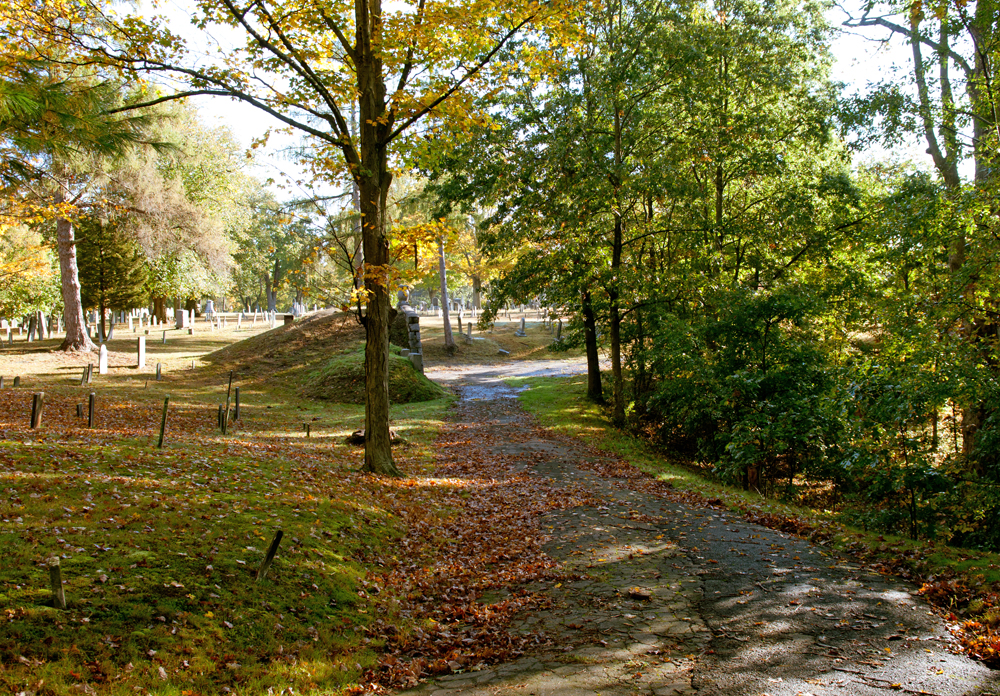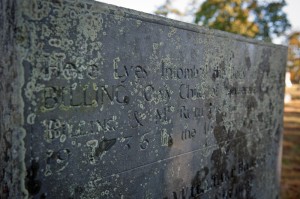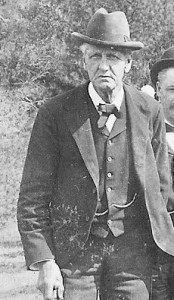True Tales from Canton’s Past: Tales from the Crypt
By George T. ComeauTake a walk with me. As the autumn leaves swirl around us, we will take the path that enters the Canton Corner Cemetery quite near the side of the Unitarian Church. The faint scent of pine greets us as we duck around the chain-link fence. Walk down past the stone receiving tomb, the crunch of leaves beneath our feet. To our right is a small dell filled with the remains of autumn, and as we rise up a small hill and just beyond a stately young maple tree, I point out the open space where hardly any graves are marked.
Walk 19 paces off the asphalt path, and we will come to a three-foot square gravestone marker. In the late 1890s, town historian Daniel Huntoon observed, “The storms of winter have almost erased the inscription.” Quite covered with lichens, gold and black, today it is just about impossible to read. At one point in the 1830s a railing protected this plot. We are standing over an ancient crypt that was built in August 1736. This is the final resting place of Ruth Billings.
The Billings family is one of Canton’s first and certainly of a prominent lineage. William Billings married Ruth Crehore of Milton in 1719, and within a year they produced their only child, Ruth. Billings came from a large family of 13 brothers and sisters, yet he only had one child of his own, and she was born when he was 35 years old and his wife was 29. At the turn of the 18th century, giving birth would have been difficult — and also fairly dangerous at the “advanced” age of 29. The birth of this wonderful child was a blessed event, and she was named Ruth after her mother and grandmother.
Ruth Billings grew up in what was then Stoughton, the part that would later become Canton. Ruth’s father was commonly referred to as Lieutenant Billings. The farm where Ruth was born comprised about 22 acres and was bounded on the northeasterly border by the Ponkapoag Plantation line, located near present-day Dedham Street.
The house must have been modest; by 1876 the only remainder of the farmhouse was an ancient cellar hole. Old timers described the house as having a pitch roof, over two rooms on the ground floor and an unfinished attic. The doors to the house opened directly out without a hallway or intervening entryway. The description is of a simple wooden building in which life seemed to revolve around the fireplace. A crane holding hooks and trammels, broad enough to “take in a log six feet long, on the hearth stood a dye pot used to color their yarn.”
Just past the Billings House was a small hill, and from the summit you would be able to see clear across the Fowl Meadows. It all sounds quite idyllic — the place names of that part of town. “To the extreme left and towards the south, the undulating line of the Sharon Hills … and looking towards South Dedham.” In plain view was Buttermilk Plain. Down toward the great Neponset River were Purgatory, Horseshoe and Hog Swamps.
On this chilly October day, standing above the tomb, the wind has shifted, and the sky becomes that autumnal grey that is a harbinger of winter. There are no other stones in the vicinity; it is noticed that no graves are located here in this plot of land. This is, in fact, the first “tomb” erected within this sacred ground. The first graves dug here were opened in 1716 when this land was part of the Meetinghouse Lot. When young Ruth died in 1736 at age 16, the family must have been shocked. And for whatever reason, Ruth’s father did not want her buried in the ground; instead he petitioned the selectmen of Stoughton for permission to build a tomb.
We have learned much about this tomb largely due to the fact that it has been opened and inspected from time to time, and a historic record exists as to its construction. The stone that is now upright was once resting as a slab atop brick masonry that was approximately two feet tall. The ghost of an inscription reads: “Here lies Intomb’d the body of Ruth Billings, Only Child of Lieutenant William Billings, and Mrs. Ruth, His Wife; who died August 19, 1736, in the 16th year of her age.”
Also in the tomb are father and mother and a fourth additional body. In 1802 the tomb was opened to place the remains of William’s nephew, Roger Billings. After that the tomb remained sealed for almost 90 years until Thursday, September 17, 1889, when two ancestors, Billings Hewett and Azel K. Billings, desired to “explore the old tomb of their kinsman.” Billings Hewett was the local sexton and drove the hearse and often worked in the cemetery; his curiosity was a natural extension of his work — and a deep connection with his family.
Local historian Samuel Noyes wrote an account in the Norfolk County Gazette: “They dug down and at a depth of seven feet came to the entrance of the vault, which was closed by a square stone of red.” They walked down several stone steps, and “entered through a low arched doorway, Mr. Billings who is six feet tall, was able to stand erect inside.” The details of the interior are fascinating and macabre: “On one side was the coffin of Lieut. Wm. Billings, which was laid there in 1769, still in perfect preservation, with the date of his birth and death on it, at the age of 82 years. At the end of the aisle, opposite the entrance was the coffin of his daughter, Ruth, who died in 1736, at the age of 16.”
And here is where things turn kind of creepy: “Mr. Hewett and Mr. Billings got some townsmen, and in their presence the lid of the young girl’s coffin was raised and it was found that her hair was in perfect preservation, and it had not lost its shape of arrangement and style of dress. All of these things were made a record of by the parish clerk, Mr. James L. Draper.”
What astonished the visitors to this crypt was the size of the vault, the workmanship, and the condition “of the remains of the inmates.” Measuring eight feet in length and six feet in width, rising about seven feet from the floor in a circular arch, the 48 square feet of space has three shelves arranged in a “U” shape around the entrance door. “The structure is of hard burnt brick, and without any doubt came from Robert Pelton’s old brick yard, which was located in the lowland of the cemetery — about a quarter of a mile distant.” As an aside, Robert Pelton, a Stoughton brick maker, was likely a brother-in-law or close relative to William Billings, and as such would have assisted in the construction of the crypt.
Clearly the vault had been constructed for three bodies, but with the addition of Roger Billings in 1802, his coffin was placed on top of his uncle’s. The “moldering remains of father, mother, daughter and nephew … are in a wonderful state of preservation, particularly these of the mother and daughter. Very little of the woodwork of the caskets remain, and the skeletons are in very good condition.” Even more gory details emerge from the 1889 expedition: “Judging from the length of the daughter’s skeleton she must have been quite tall; and from the high and prominent frontal development of the skull, she must have had large intellectual capacities.”
The death of a child is a tragedy that is impossible to comprehend. And the cause of this death occurring over 275 years ago is pure conjecture. But, here again, theories abound: “Tradition tells that this only child was an idolized daughter, when at the age of 16 years, attended a party, or evening festivity in a low neck dress, which indiscretion resulted in a fatal sickness.” Another theory asserts that “Ruth, who was a beautiful girl, went to a ball with thin-soled shoes, through which indiscretion she took a violent cold which resulted in consumption and finally death.”
From whatever fate brought death to young Ruth, her family clearly loved her. It is said that Ruth’s parents bought her an extravagant dress made of the finest imported calico, and that is the dress she was buried in. It would be 33 years that her body, dressed in calico, would lie in the tomb alone, until her father was placed alongside her remains in 1769.
Aside from the morbid details and the apocryphal stories surrounding the death of this young girl, what stands out the brightest is the passion and dedication of William Billings, who built a home as a final resting place for his only daughter. As we leave the ground covering the tomb, let’s walk for a moment just to our left and stop by one last gravesite — that of a relative of Ruth Billings, a cousin perhaps, Vaushty Billings.
Buried in 1797 at the age of 21 years and six months, Vaushty’s gravestone has a clear message for guiding our understanding of death. “Young people dear come drop a tear, remember well my fate: Make peace with God, believe his word, before it be to late. Tho cruel death hath stop’t my breath, I cannot speak to thee; yet may my death a warning prove of thy mortality.”
Short URL: https://www.thecantoncitizen.com/?p=16670













